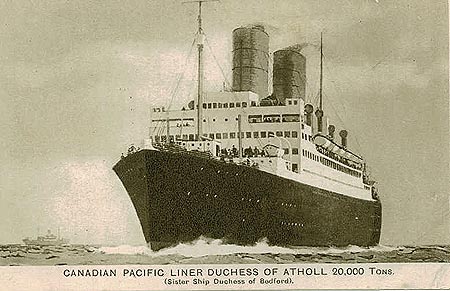 The Duchess of Atholl
The Duchess of Atholl
The Steamship Duchess of Atholl was built in 1928 for Canadian Pacific by the William Beardmore & Company in Glasgow, Scotland. She had the capacity to carry 1,563 passengers who were divided into 573 cabin class, 480 tourist class and 510 third class. She usually sailed the Liverpool to Canada route.
During the ten years that the Duchess steamed across the Atlantic, she carried only 587 British Home Children to Canada as compared to the thousands of children other ships brought here earlier in the 1920s. The child migrant scheme was starting to slow down because of the Great Depression. Many fully-grown men roamed the countryside willing to work for room and board and looked unkindly upon the children who could be kept cheaper than them.
The Duchess was requisitioned and converted into a troopship in 1939, but her service was short lived. it was only three years later on October 10, 1942 that she was torpedoed by a U Boot about 200 miles northeast of Ascension Island.
She lost speed, turned to port and all her lights went out. Almost immediately she became immobile. Two more torpedoes struck and the captain ordered all 534 passengers to abandon ship. On board were 236 soldiers, 196 navy personnel, 97 members of the RAF, five nurses and 291 civilians, including many women and children.
The crew members abandoned ship shortly thereafter. Before leaving, they made sure that all confidential books, papers and nine special bags of mail had been thrown overboard.
The Duchess capsized to port and sank gently.
The U Boot surfaced and the captain informed the survivors that they had sent out an SOS signal and that, as it would take some time for another ship to reach them, they should stick together. He then requested information about the name of the ship, their cargo and their intended destination. The submarine then submerged leaving the people to fend for themselves on a swelling sea.
Most of the passengers and crew experienced severe sea-sickness and were dehydrated by the time the HMS Corinthian was able to locate them. They had followed the wireless distress signal being sent out from the lifeboats. On October 11, all passengers were picked up within five hours and were taken to Freetown.
In the attack, four crew members lost their lives and two crew members and two passengers were injured.
